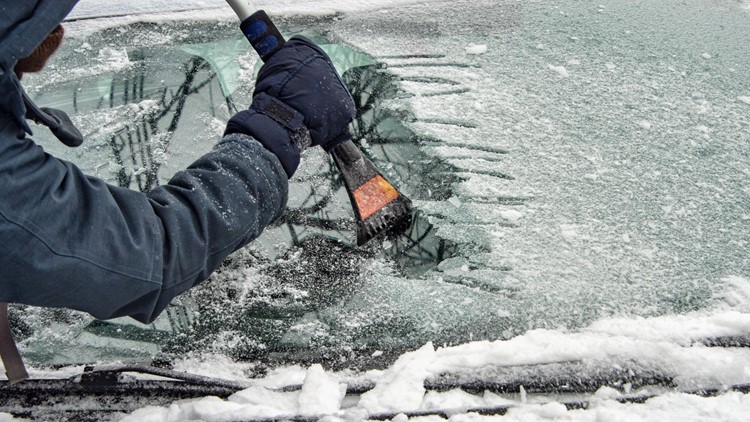ST. LOUIS — Another round of wintry weather has arrived in the St. Louis area. While many people have heeded the warning to stay off the roads, sometimes you just need to get somewhere.
If you don't have the good fortune to have a covered parking spot or you forgot to cover up your windshield, you may have some work to do before you can safely get behind the wheel.
Before you head out to crank up the defroster and get to scraping, here are a few tips and tricks to make the job a little bit easier, and some things to avoid when clearing off your car.
Brush off as much as you can
With some of our recent storms, rain has transitioned to ice and snow, which can leave a few layers on your car. If you brush off as much as you can, you'll have a better idea of what you need to scrape, and what tools will work best.
Try a de-icer
Whether it's homemade or store-bought, de-icing solutions can save you a lot of time and energy. The idea behind a de-icer is to lower the freezing point of what is on your car. We know water freezes at 32 degrees, so anything below that will make it harder for the ice to stick around.
You can go out and buy cans or spray bottles of solution, but if you don't have one on hand, you might be able to make one with things you have in your house right now. AAA suggests a mixture of one part isopropyl alcohol to two parts water. Use a spray bottle to disperse it on your windows to help speed up melting. Some isopropyl alcohols have a freezing point as low as 128 degrees below zero.
Once applied, use your scraper, brush or windshield wipers (if they are cleared) to wipe the mixture away.
Some commercial options come with a scraper attached for an all-in-one option.
Ice scraper secrets
Sometimes that layer of ice is just too thick to get under it with just the main side of the scraper, but what about the other side? Many scrapers have smaller, spaced-out portions that can loosen some of the stubborn ice. Once you're done, flip the scraper back over and take it off the rest of the way.
Here's a look at this one in action.
Don't use any metal scrapers, which can damage the glass.
Don't leave your car running unattended
You don't have to look very hard to find a story about someone getting their car stolen while it was left running to warm up. If you're going to rely on your car's heater to help melt the ice, make sure you are behind the wheel with the doors locked. If you get out of the car, take the keys out of the ignition with you.
If you do use your car's heater to help melt the ice, AAA suggests these three settings:
- Set the heater to defrost
- Adjust the airflow to recirculate
- Move the temperature control to full heat
Watch your step
If there's ice on your car, there's a good chance there's ice on the ground as well. If you are trying to use a scraper, that force you are trying to apply could knock you off balance and lead to a fall.
Make sure you have solid footing and good traction before really getting started.
Don't use a torch or boiling water
Pouring hot water or using a flame can seem like an obvious way to remove ice, but the rapid heating of the glass can cause it to crack or shatter.
Don't use your wipers until they are cleared
If you forgot to put up your windshield wipers before the storm, you may find them covered like everything else. Avoid turning them on until you have cleared them of ice and unstuck them from the windshield. If not, you could damage the blades or the motors that drive them.
Getting ready for next time
The best way to clear ice from your car is to keep it off in the first place. Before the next storm, put a windshield cover on your car so you can peel that ice and snow off in one fell swoop.
If you don't have a windshield cover, a tarp or old shower curtain could work as well. You could also use a cardboard box, but rain or wet snow could leave you with an even bigger mess.
You can also put bread bags over your wipers and freezer bags over the rearview mirrors.
Make sure you plan ahead and leave plenty of time to clear your car completely. Having as much visibility as possible is crucial, especially when road conditions are bad.



